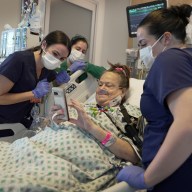 Amanda Seyfried plays “Deep Throat” star Linda Boreman in “Lovelace.”
Amanda Seyfried plays “Deep Throat” star Linda Boreman in “Lovelace.”
Credit: Getty Images
Amanda Seyfried has a wholesome image, but she’s far from alien to edgier fare. Apart from the five seasons she spent on “Big Love,” the star of musicals like “Mamma Mia!” and “Les Miserables” has been in the transgressive pictures “Alpha Dog,” “Jennifer’s Body” and “Chloe.” In “Lovelace,” she portrays Linda Boreman (better known for her stage surname, Lovelace). The first porn star to become a household name, Boreman was forced into doing “Deep Throat” in the 1970s by her abusive husband (played by Peter Sarsgaard).
How did your perception of Linda Boreman change after you made this film?
She was a woman caught in the wrong circumstances. She made a few wrong choices, and she got lost. And she tried to find herself. She didn’t give up. She fell and got back up. She’s way stronger than people ever gave her credit for. But she had a s— life. Her only saving grace was having those two amazing children. She’s been defined by this one experience.
Were you hesitant to take the role?
I wasn’t that hesitant. Maybe at first. Because you’re always thinking, is this movie better than some other movie I could do at the same time? After I met [directors] Rob [Epstein] and Jeff [Friedman], I thought these people could tell her story in a beautiful way.
Boreman’s not a very autonomous character.
It’s not the way I would react to things. But at the same time I understood where she was coming form. She was pretty shy. She was really naive. She was poorly educated. She made the mistake of escaping from her repressive, strict Catholic home into the arms of someone who was not going to save her, who was going to take her down even further.
Is it difficult to convey feelings without dialogue explaining them?
I think it’s sometimes easier when you don’t have lines, because you can convey a lot in the way you react to things. It was easier with Peter, in reacting to his character. She would just go along with it. She was starry eyed.
Did Sarsgaard make it easier?
He just made me feel safe. He said to relate to someone as a monster you have to think of them as a baby first. You have to relate to them as if they were a child you were protecting. That really works. He made Chuck so sad at times. This guy’s such a useless, insecure little creep. Abusing women was his only power — that’s what’s so sad about him. He took his power from beating a woman. And that makes a monster, but also a p—y.
Were the sex scenes difficult to do, or did you just giggle through them?
The sex scenes were easy. It’s silly. They’re just silly. They’re all silly. The violent scenes were not so silly. They weren’t so easy. But they’re not terrifying, because you have a structure. Everything’s choreographed.
How was getting into the ‘70s vibe?
That was so fun. I had five wigs. I’m not going to tell you I didn’t have fun rollerskating for two days straight. There’s so much comedy in this movie as well. I made fun of Peter’s cameltoe daily. I’ve always felt if I had been born in the ‘60s, I could have experienced the ‘70s and ‘80s. I probably would have moved to London in the ‘80s, if I had been aware of what was happening.
















